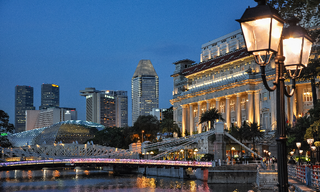Min Lan Tan: Asia «More Equipped» for Trump 2.0
Economic growth in Asia faces the threat of US tariffs under President-elect Donald Trump. However, the region is «more equipped» to deal with such trade challenges this time around, according to UBS’ Min Lan Tan.
The threat of 60 percent tariffs on China and 10 percent on others under US President-elect Donald Trump looms large, posing Asia's especially challenging economic outlook. Whether this is a negotiation tactic or reality remains to be seen. Nonetheless, Asia is in a different position than the last Trump term, with trade positions recalibrated.
«In Asia, China will bear the brunt of board-based discriminatory tariffs. Elsewhere, which economies get hit with selective tariffs, and which get carveouts is less clear. But the specter of tariffs will be an overhang on growth,» said Min Lan Tan, head chief investment office APAC at UBS Global Wealth Management in a statement. «Still, compared to Trump 1.0, the region is now more equipped to manage these challenges.»
China Forecast
According to a report by UBS, its base case for China is for tariffs to triple from about 10 percent currently to 30 percent by the end of 2026. It predicts that this will result in a cumulative growth drag of 70 to 100 basis points with the Chinese government responding with a 2-4 trillion yuan ($280-550 billion) fiscal package to maintain growth at the mid-4 percent range.
But should the US impose the full 60 percent tariff, it predicts a 200-300 basis point drag over three years with growth slowing towards 4 percent in 2025 and 3 percent in 2026. A positive surprise of a much more forceful stimulus package of at least 5-8 trillion yuan would be required to achieve a run rate of about 5 percent annually in the next few years.
Trade War Response
With regards to a response in trade, the bank believes that China could retaliate «in an asymmetric and measured fashion, including through tit-for-tat tariffs on targeted goods, tighter restrictions on critical mineral exports, and sanctions on individuals and companies».
«In terms of concessions, Beijing would likely be willing to purchase more agricultural goods, LNG, and services from the US,» UBS said. «Externally, China will likely continue to pursue more non-US trade partnerships and promote 'going global' strategies – e.g., rising FDI and intermediate trade to countries (especially EM) to dilute the tariff impact over time.»
Small and Open Versus Large and Domestic
Elsewhere in Asia, tariffs will have varying effects.
UBS said that smaller open economies like South Korea, Taiwan, Thailand, Malaysia and Singapore are likely to face the greatest impact in contrast with large domestically-oriented economies like India, Indonesia and the Philippines.
Benign Growth
Overall, UBS' base case, on which it places a 50 percent probability, is for the world to undergo benign growth. It expects US equities to rise with growth backed by deregulation and improved business confidence. Inflation will fall towards the target. In contrast, European and Chinese markets will face volatility and underperformance due to trade and geopolitical negotiations.
Bond yields will fall slightly while central banks consistently cut interest rates toward neutral levels. Its targets for end-2025 include 6,600 for the S&P 500, 4 percent yield for the US 10-year Treasury and 1.12 for EUR/USD.


























